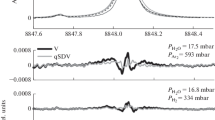Abstract—
The study of the vibrational dependence of H2O polarizability α is based on the comparison of experimental and calculated line shifts induced by argon, nitrogen, and air pressure in different H2O vibrational bands. The dependence of α on the internal coordinate θ, which describes large-amplitude bending vibration in the molecule, is expressed by a power series. The coefficients of the power series were selected so as to ensure the best agreement between the calculated matrix elements 〈ψn|α(θ)|ψn〉 and the polarizability values α(n) derived from the analysis of experimental H2O absorption line shifts in nν2 vibrational bands by nitrogen, oxygen, air, and argon pressure. The rotational contributions in the effective H2O polarizability are calculated and discussed. The α(θ) representation found is compared with ab initio calculations.


Similar content being viewed by others
REFERENCES
A. D. Bykov, L. N. Sinitsa, and V. I. Starikov, Experimental and Theoretical Techniques in Water Vapor Spectroscopy (Publishing House of SB RAS, Novosibirsk, 1999) [in Russian].
V. I. Starikov and Vl. G. Tyuterev, Intramolecular Interactions and Theoretical Techniques in the Spectroscopy of Non-rigid Molecules (Spektr, Tomsk, 1997) [in Russian].
V. I. Starikov, “Vibration-Rotation Interaction Potential for H2O-A System,” J. Quant. Spectrosc. Radiat. Transfer 155, 49–56 (2015).
S. L. Shostak and J. S. Muenter, “The dipole moment of water. ii. analysis of the vibrational dependence of the dipole moment in terms of a dipole moment function,” J. Chem. Phys. 94, 5883–5890 (1991).
M. Mengel and P. Jensen, “A theoretical study of the stark effect in triatomic molecules: Application to H2O,” J. Mol. Spectrosc. 169, 73–91 (1995).
Y. Luo, H. Agren, O. Vahtras, P. Jorgensen, V. Spirko, and H. Hettema, “Frequency-dependent polarizabilities and first hyperpolarizabilities of H2O,” J. Chem. Phys. 98, 7159–7164 (1993).
T. M. Petrova, A. M. Solodov, A. A. Solodov, and V. I. Starikov, “Measurements and calculations of Ar-broadening and -shifting parameters of the water vapor transitions in the wide spectral region,” Mol. Phys. 115, 1642–1656 (2017).
V. I. Starikov, T. M. Petrova, A. M. Solodov, A. A. Solodov, and V. M. Deichuli, “Study of the H2O dipole moment and polarizability vibrational dependence by the analysis of rovibrational line shifts,” Spectochimica Acta. A 210, 275–280 (2019).
V. I. Starikov and A. E. Protasevich, “Effective polarizability operator for X2Y-type molecules. Application to line width and line shift calculations of H2O,” J. Mol. Struct. 646, 81–88 (2003).
A. R. Hoy, I. M. Mills, and G. Strey, “Anharmonic force constant calculations,” Mol. Phys. 24, 1265–1290 (1972).
W. F. Murphy, “The ro-vibrational raman spectrum of water vapour ν2 and 2ν2,” Mol. Phys. 33, 1701–1714 (1977).
W. F. Murphy, “The ro-vibrational Raman spectrum of water vapour ν1 and ν3,” Mol. Phys. 36, 727–732 (1978).
G. Avila, J. M. Fernandez, B. Mate, G. Tejeda, and S. Montero, “Ro-vibrational raman cross sections of water vapor in the OH stretching region,” J. Mol. Spectrosc. 196, 77–92 (1999).
G. Avila, G. Tejeda, J. M. Fernandez, and S. Montero, “The Raman spectra and cross sections of the ν2 band of H2O, D2O, and HDO,” J. Mol. Spectrosc. 223, 166–180 (2004).
G. Avila, G. Tejeda, J. M. Fernandez, and S. Montero, “The rotational Raman spectra and cross sections of H2O, D2O, and HDO,” J. Mol. Spectrosc. 220, 259–275 (2003).
G. Avila, “Ab initio dipole polarizability surfaces of water molecule: static and dynamic at 514.5 nm,” J. Chem. Phys. 122, 144310 (2005).
O. Loboda, F. Ingrosso, M. F. Ruiz-Lopez, H. Reis, and C. Millot, “Dipole and quadrupole polarizabilities of the water molecule as a function of geometry,” J. Comput. Chem. 37, 2125–2132 (2016).
J. T. Hougen, P. R. Bunker, and J. W. G. Johns, “The vibration-rotation problem in triatimic molecules for a large-amplitude bending vibration,” J. Mol. Spectrosc. 34, 136–172 (1970).
V. I. Starikov, “ν2-dependences of the rotational contributions to the effective dipole moment of the H2O molecule and their effect on the broadening and shift of lines induced by the pressure of buffer gases,” Opt. Spectrosc. 127 (2), 200–206 (2019).
Yu. S. Makushkin and Vl. G. Tyuterev, Perturbation Theory Methods and Effective Hamiltonians in the Molecular Spectroscopy (Nauka, Novosibirsk, 1984) [in Russian].
D. Robert and J. Bonamy, “Short range force effects in semiclassical molecular line broadening calculations,” J. Phys. (Paris) 40, 923–943 (1979).
R. P. Leavitt, “Pressure broadening and shifting in microwave and infrared spectra of molecules of arbitrary symmetry: An irreducible tensor approach,” J. Chem. Phys. 73 (11), 5432–5450 (1980).
V. I. Starikov and N. N. Lavrent’eva, Collisional Broadening of Spectral Lines of Absorption of Molecular Atmospheric Gases (Publishing House of IAO SB RAS, Tomsk: 2006) [in Russian].
N. Schmucker, Ch. Trojan, T. Giesen, R. Schielder, K. M. T. Yamada, and G. Winnewisser, “Pressure broadening and shift of some H2O lines in the ν2 |band: Revisited,” J. Mol. Spectrosc. 184, 250–256 (1997).
R. A. Toth, “Measurements and analysis (using empirical functions for widths) of air- and self-broadening parameters of H2O,” J. Quant. Spectrosc. Radiat. Transfer 94, 1–50 (2005).
Author information
Authors and Affiliations
Corresponding author
Ethics declarations
The author declares that he has no conflicts of interest.
Additional information
Translated by O. Ponomareva
Rights and permissions
About this article
Cite this article
Starikov, V.I. Study of H2O Polarizability Based on Data on Rovibrational Line Shifts by Buffer Gas Pressure. Atmos Ocean Opt 33, 324–331 (2020). https://doi.org/10.1134/S102485602004017X
Received:
Revised:
Accepted:
Published:
Issue Date:
DOI: https://doi.org/10.1134/S102485602004017X




